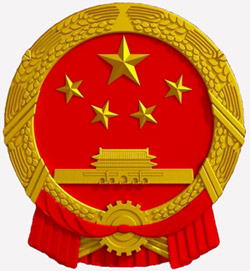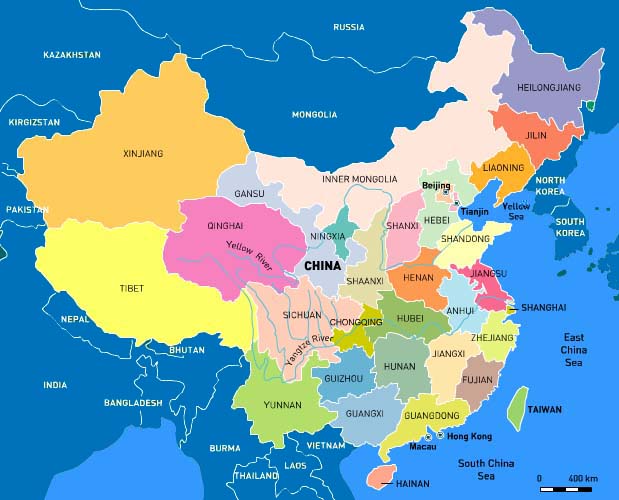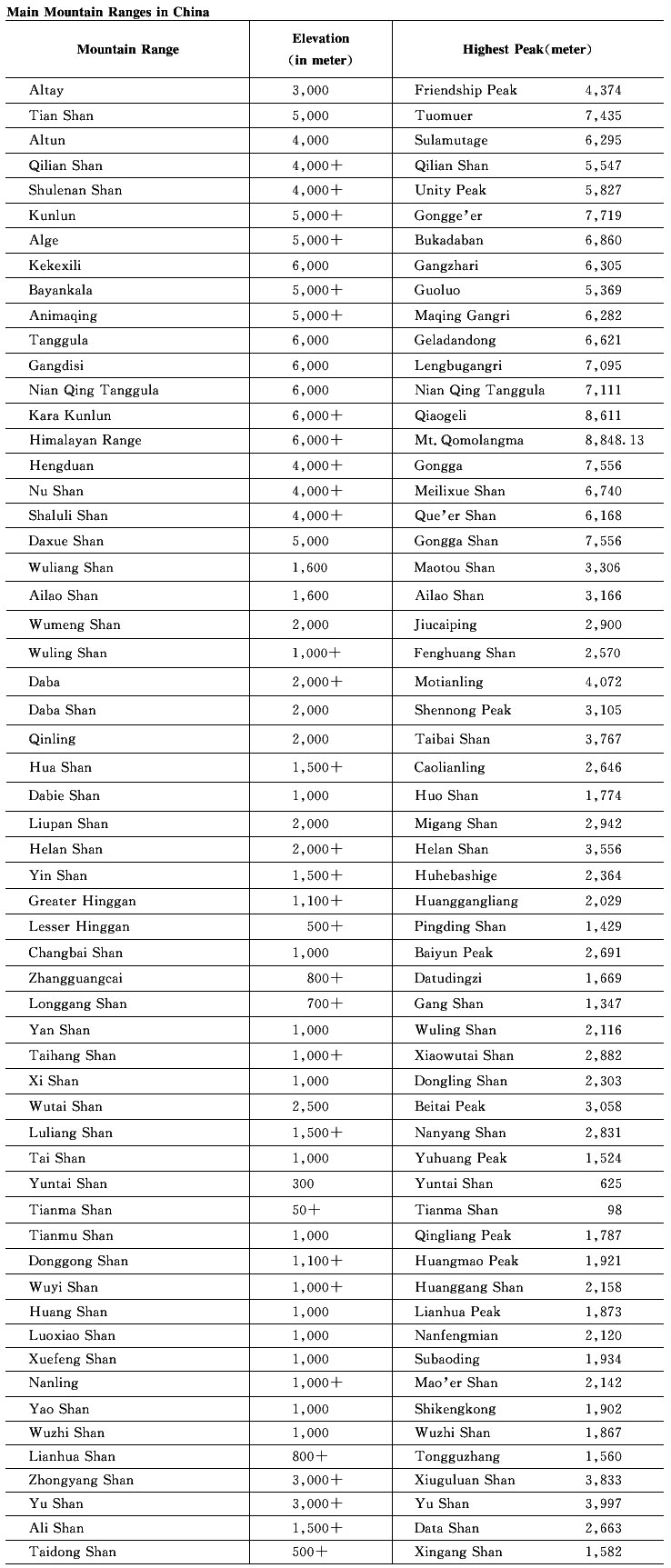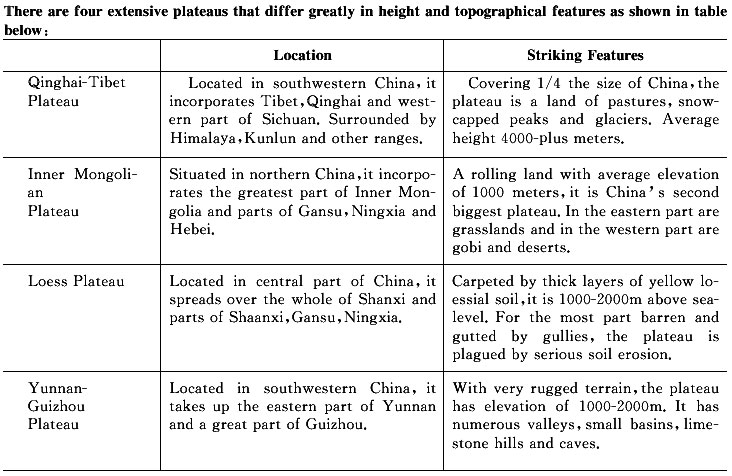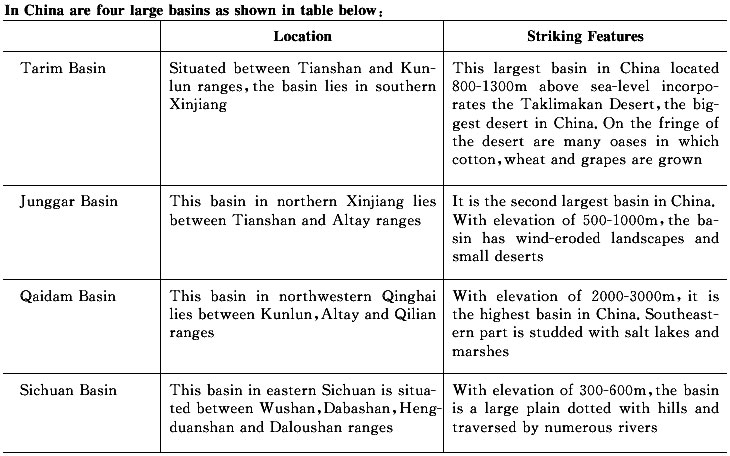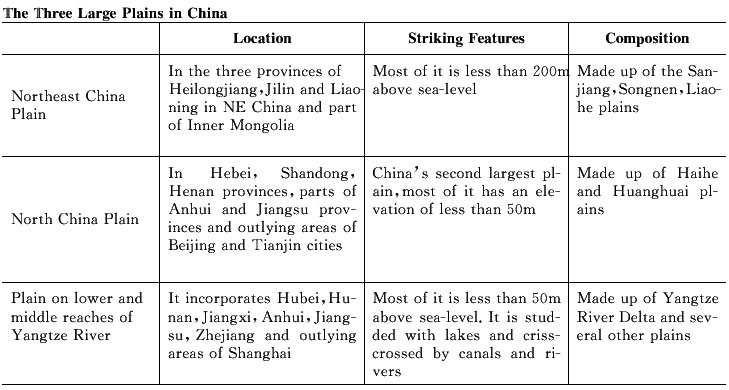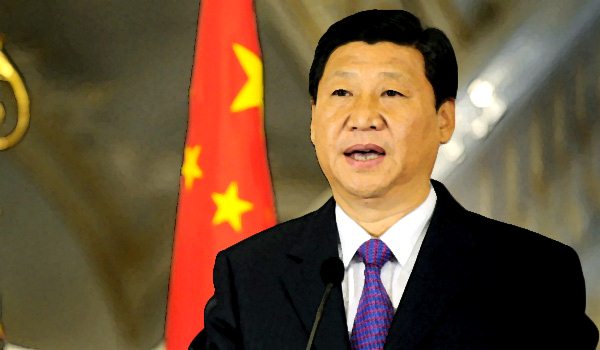
|
||||||||||||
|
|
|
People's Republic of China
China is a country with a very early civilization and a long and rich history. The compass, gunpowder, the art of paper-making and block printing invented by the ancient Chinese have contributed immensely to the progress of mankind. The Great Wall, Grand Canal and other projects built by the Chinese people are regarded as engineering feats in the world. Man has lived for a very long time in what is now China, according to archaeological finds. In many parts of the country, for instance, fossil remains of primitive ape men have been unearthed. Among them are the fossil remains of the Yuanmou Ape Man who lived in Yunnan Province some 1.7 million years ago. Research findings show that the Peking Man, who lived about 500,000 years ago, was able to make and use simple implements and knew the use of fire. Like all other peoples on earth, the Chinese have passed through the primitive, matriarchal and patriarchal communes. As one of the Four Great Ancient Civilizations, China has a recorded history of more than 4,000 years. Evidence of the cultivation of rice and millet using farming tools dating back to six to seven thousand years ago was discovered in Hemudu Town of Yuyao City, Zhejiang Province, and Banpo Village near Xian City, Shaanxi Province. In 2070 BC, the first Chinese dynasty - Xia Dynasty was established. This brought into being a society based upon slavery and China experienced about 1,300-year's rule by the Xia, Shang, and Western Zhou Dynasties. This era was followed by the Eastern Zhou Dynasty also named Spring and Autumn and Warring States periods during which silk production advanced and steel production started. At the same time, many scholars rose to fame despite continual wars and chaos. These included philosophers Lao Zi, Confucius, Mencius and Mo Zi as well as the militarist Sun Wu. In 221 BC, Ying Zheng, ruler of the Qin State with great talent and bold vision, established the first centralized, unified, multi-ethnic feudal state in Chinese history - the Qin Dynasty, bringing to an end over 250 years of rivalry among the vassals during the Warring States Periods. From that time on China was subject to a long period of feudal society that lasted for nearly 2,100 years, which was the dominant stage of the country's ancient history. During the feudal period, under the rule of many wise emperors, China was one of the world's greatest economies especially during the Han and Tang Dynasties. At the end of the Qing Dynasty, the Republic of China rose from the chaos, thereby establishing the country as a modern capitalist society. This lasted for a short but turbulent period until the foundation of the People's Republic of China on January 1, 1949. This had the effect of totally changing the fortune of the Chinese people's fortune as the nation entered the socialist era that we know today.
For centuries China stood as
a leading civilization, outpacing the rest of the world in the arts
and sciences, but in the 19th and early 20th centuries, the country
was beset by civil unrest, major famines, military defeats, and
foreign occupation. After World War II, the Communists under MAO
Zedong established an autocratic socialist system that, while ensuring
China's sovereignty, imposed strict controls over everyday life and
cost the lives of tens of millions of people. After 1978, MAO's
successor DENG Xiaoping and other leaders focused on market-oriented
economic development and by 2000 output had quadrupled. For much of
the population, living standards have improved dramatically and the
room for personal choice has expanded. China since the early 1990s has
increased its global outreach and participation in international
organizations.
National emblem: Tiananmen Gatetower under five stars, encircled by ears of grain and with a gear wheel below. On June 18, 1950, the Second Session of the First CPPCC National Committee adopted the design and illustration of the national emblem of the PRC. On September 27 that year, Chairman Mao Zedong ordered the promulgation of the national emblem. Composed of patterns of the national flag, the Tian'anmen Rostrum, a wheel gear and ears of wheat, it symbolizes the New-Democratic Revolution of the Chinese people since the May 4th Movement (1919) and the birth of New China under the people's democratic dictatorship led by the working class on the basis of the worker-peasant alliance.
Ethnic Groups: China is a united multi-ethnic nation of 56 ethnic groups. As the majority (91.6 percent) of the population is of the Han ethnic group, China's other 55 ethnic groups are customarily referred to as ethnic minorities. According to the fifth national census in 2000, 18 ethnic minorities have a population of over one million, namely the Zhuang, Manchu, Hui, Miao, Uygur, Yi, Tujia, Mongolian, Tibetan, Bouyei, Dong, Yao, Korean, Bai, Hani, Li, Kazak and Dai. Of these the Zhuang ethnic group has the biggest population, numbering 16.179 million. There are 17 ethnic groups with a population of between 100,000 and one million, namely the She, Lisu, Gelao, Lahu, Dongxiang, Va, Sui, Naxi, Qiang, Tu, Xibe, Mulam, Kirgiz, Daur, Jingpo, Salar and Maonan. There are 20 ethnic groups with a population of between 10,000 and 100,000, namely, Blang, Tajik, Primi, Achang, Nu, Ewenki, Gin, Jino, Deang, Ozbek, Russian, Bonan, Monba, Oroqen, Derung, Tatar, Hezhen, Gaoshan (excluding the Gaoshan ethnic group in Taiwan) and Lhoba. The Lhoba ethnic group, at 2,965, has the smallest population. The Han people can be found throughout the country, mainly on the middle and lower reaches of the Yellow River, the Yangtze River and the Pearl River valleys, and the Northeast Plain. The 55 ethnic minorities, though fewer in number, are also scattered over vast areas and can be found in approximately 64.3 percent of China, mainly distributed in the border areas of northeast, north, northwest and southwest China. Yunnan Province, home to more than 20 ethnic groups, has the greatest diversity of ethnic groups in China. Over China's long history, repeated instances of ethnic group migrations, opening up new land for cultivation, emigration, relocation of the ruling dynasty, and a host of other reasons, gave rise to the situation of “living together over vast areas while some living in compact communities in small areas.” This continues to provide the practical basis for political, economic and cultural intercourse between the Han and the various minority peoples, and for the functioning of the regional ethnic autonomy system.
With a landmass of 9,600,000 sq km, China is the third largest country in the world. Located in the east of the Asian continent, on the western shore of the Pacific Ocean, the People's Republic of China has a land area of about 9.6 million sq km, and is the third-largest country in the world, next only to Russia and Canada. From north to south, the territory of China stretches from the center of the Heilong River north of the town of Mohe to the Zengmu Reef at the southernmost tip of the Nansha Islands, covering a distance of 5,500 km. From east to west, the nation extends from the confluence of the Heilong and Wusuli rivers to the Pamirs, covering a distance of 5,200 km. With a land boundary of some 22,800 km, China is bordered by Korea to the east; Mongolia to the north; Russia to the northeast; Kazakhstan, Kyrgyzstan and Tajikistan to the northwest; Afghanistan, Pakistan, India, Nepal and Bhutan to the west and southwest; and Myanmar, Laos and Vietnam to the south. Across the seas to the east and southeast are the Republic of Korea, Japan, the Philippines, Brunei, Malaysia and Indonesia. China's mainland coastline measures approximately 18,000 km, with a flat topography, and many excellent docks and harbors, most of which are ice-free all year round. The Chinese mainland is flanked to the east and south by the Bohai, Yellow, East China and South China seas, with a total maritime area of 4.73 million sq km. The Bohai Sea is China's continental sea, while the Yellow, East China and South China seas are marginal seas of the Pacific Ocean. A total of 5,400 islands dot China's territorial waters. The largest of these, with an area of about 36,000 sq km, is Taiwan, followed by Hainan with an area of 34,000 sq km. The Diaoyu and Chiwei islands, located to the northeast of Taiwan Island, are China's easternmost islands. The many islands, islets, reefs and shoals in the South China Sea, known collectively as the South China Sea Islands, are China's southernmost island group. They are called the Dongsha (East Sandbar), Xisha (West Sandbar), Zhongsha (Middle Sandbar) and Nansha (South Sandbar) island groups according to their geographical locations. The topography varies greatly in China, a vast land of lofty plateau, large plains, rolling land and big and small basins surrounded by lofty mountains. All the five basic topographic types in the world exist in China to create the conditions for developing industry and agriculture. Mountainous land and very rough terrains make up 2/3 of Chinese territory, and this has created some problems in transport and in the development of agricultural production. However such topographical features are conducive to the development of forestry, mineral and hydropower resources and tourism.
With highlands in the west and plains in the east, China has a varied topography. The lie of the land may be divided into three tiers. The Qinghai-Tibet Plateau that rises more than 4, 000m above sea-level forms the highest tier. It is a land of peaks and valleys studded with innumerable lakes. Along the plateau's southwestern fringe is the Himalayan Range, on the eastern section of which looms the 8, 848. 13 meter-high Mt. Qomolangma, the world's loftiest peak. The vast area north and east of the Qinghai-Tibet Plateau that drops to an elevation below 1, 100-2, 000m forms the second tier-a land interspersed with extensive basins and highlands. Here the Turpan Basin in Xinjiang is 154m below sea-level-the lowest depression in China. The third tier is a vast area of rolling hills and plains with an elevation below 500m lying east of the line running from the Greater Hinggan and Taihang ranges in the north to the foothills of the Wushan Mountains and the Yunnan-Guizhou Highlands in the south. Though some peaks in this area are as high as 2, 000m, the plains along the coast have an elevation of less than 50m. Off the Chinese coast is an extensive continental shelf richly endowed with petroleum, natural gas and marine resources. There are many mountain ranges in China. Those extending from east to west are the Tianshan-Yinshan ranges and those in the center are the Kunlun-Qinling ranges, and those in the south are the Nanling ranges. Ranges that stretch in a NE-SW direction are, for the most part, located in the eastern part of China. They are the Greater Hinggan Range, Taihang, Wushan, Xuefengshan, Changbaishan and Wuyishan ranges. Those running in a NW-SE direction are the Altai and Qilianshan ranges. Ranges that run in a north-south direction are the Hengduanshan and Helanshan ranges. And on the border between China and India, Nepal and other countries looms the 2, 400 kilometers-long Himalayan Range with an average elevation of 6, 000m.
In China are three large plains with fertile soil, on which crops grow in luxuriant, as well as many small ones in the Chengdu area, the Pearl River Delta, western Taiwan Province and other areas:
23 provinces (sheng,
singular and plural), 5 autonomous regions (zizhiqu, singular and
plural), and 4 municipalities (shi, singular and plural)
provinces:
Anhui, Fujian, Gansu, Guangdong, Guizhou, Hainan, Hebei, Heilongjiang,
Henan, Hubei, Hunan, Jiangsu, Jiangxi, Jilin, Liaoning, Qinghai,
Shaanxi, Shandong, Shanxi, Sichuan, Yunnan, Zhejiang;
autonomous regions:
Guangxi, Nei Mongol, Ningxia, Xinjiang Uygur, Xizang (Tibet)
municipalities:
Beijing, Chongqing, Shanghai, Tianjin
President of China XI Jinping Xi Jinping replaced Hu Jintao as head of the Chinese Communist Party on November 14.2012, ushering in the fifth generation of leaders set to run the world’s second-biggest economy over the next decade. He was also named chairman of the party’s Central Military Commission. Xi Jinping, was was named general secretary of the 82- million member Communist Party and is set to take over the presidency, a mostly ceremonial post, from Hu Jintao in March. He served in top positions in prosperous coastal regions, including Fujian, Zhejiang and Shanghai, from 1985 through 2007, winning praise for his pro-market policies. Since returning to Beijing, Xi has also headed the Communist Party’s main cadre training school, where he makes speeches laced with references to Karl Marx and Vladimir Lenin. A visit to the U.S. in February took him back to Muscatine, Iowa, where he spent time in 1985 studying farming techniques. The son of one of the revolutionary founders of the Communist state, he is married to Peng Liyuan, a popular Chinese folksinger. Their only daughter is an undergraduate at Harvard University. A Brief Chinese Chronology
Introduction ::China Background: For centuries China stood as a leading civilization, outpacing the rest of the world in the arts and sciences, but in the 19th and early 20th centuries, the country was beset by civil unrest, major famines, military defeats, and foreign occupation. After World War II, the Communists under MAO Zedong established an autocratic socialist system that, while ensuring China's sovereignty, imposed strict controls over everyday life and cost the lives of tens of millions of people. After 1978, MAO's successor DENG Xiaoping and other leaders focused on market-oriented economic development and by 2000 output had quadrupled. For much of the population, living standards have improved dramatically and the room for personal choice has expanded, yet political controls remain tight. China since the early 1990s has increased its global outreach and participation in international organizations. Geography ::China Location: Eastern Asia, bordering the East China Sea, Korea Bay, Yellow Sea, and South China Sea, between North Korea and Vietnam Geographic coordinates: 35 00 N, 105 00 E Map references: Asia Area: total: 9,596,961 sq km country comparison to the world: 4 land: 9,569,901 sq km water: 27,060 sq km Area - comparative: slightly smaller than the US Land boundaries: total: 22,117 km border countries: Afghanistan 76 km, Bhutan 470 km, Burma 2,185 km, India 3,380 km, Kazakhstan 1,533 km, North Korea 1,416 km, Kyrgyzstan 858 km, Laos 423 km, Mongolia 4,677 km, Nepal 1,236 km, Pakistan 523 km, Russia (northeast) 3,605 km, Russia (northwest) 40 km, Tajikistan 414 km, Vietnam 1,281 km regional borders: Hong Kong 30 km, Macau 0.34 km Coastline: 14,500 km Maritime claims: territorial sea: 12 nm contiguous zone: 24 nm exclusive economic zone: 200 nm continental shelf: 200 nm or to the edge of the continental margin Climate: extremely diverse; tropical in south to subarctic in north Terrain: mostly mountains, high plateaus, deserts in west; plains, deltas, and hills in east Elevation extremes: lowest point: Turpan Pendi -154 m highest point: Mount Everest 8,850 m Natural resources: coal, iron ore, petroleum, natural gas, mercury, tin, tungsten, antimony, manganese, molybdenum, vanadium, magnetite, aluminum, lead, zinc, rare earth elements, uranium, hydropower potential (world's largest) Land use: arable land: 14.86% permanent crops: 1.27% other: 83.87% (2005) Irrigated land: 545,960 sq km (2003) Total renewable water resources: 2,829.6 cu km (1999) Freshwater withdrawal (domestic/industrial/agricultural): total: 549.76 cu km/yr (7%/26%/68%) per capita: 415 cu m/yr (2000) Natural hazards: frequent typhoons (about five per year along southern and eastern coasts); damaging floods; tsunamis; earthquakes; droughts; land subsidence volcanism: China contains some historically active volcanoes including Changbaishan (also known as Baitoushan, Baegdu, or P'aektu-san), Hainan Dao, and Kunlun although most have been relatively inactive in recent centuries
Credit: CIA Fact Book, People's Republic of China |

